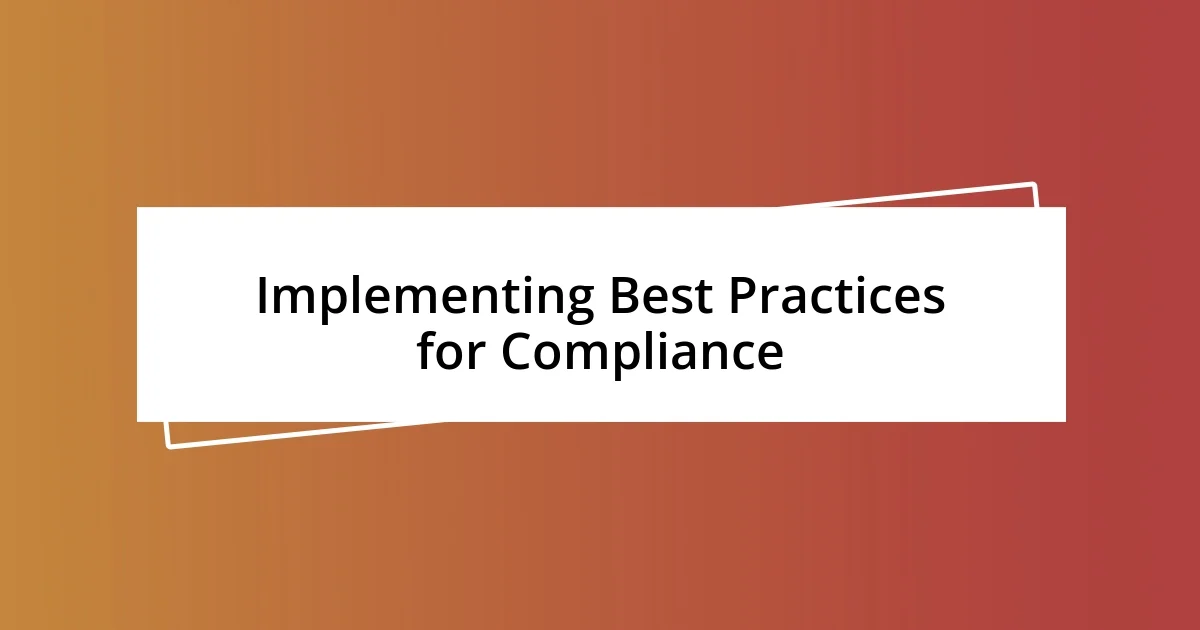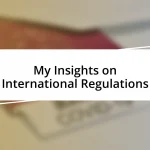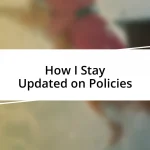Key takeaways:
- Understanding and staying informed about regulatory changes is crucial for managing investments and ensuring compliance in the rapidly evolving crypto landscape.
- Developing a proactive compliance strategy, including record-keeping and engaging with experts, can transform uncertainty into a manageable routine.
- Sharing experiences and fostering transparency within a network helps build trust and resilience in navigating regulatory challenges.

Understanding the Crypto Regulatory Landscape
Navigating the crypto regulatory landscape can feel like stepping into a labyrinth without a map. I remember the confusion I faced when new guidelines rolled out in my region; it was like trying to catch smoke with my bare hands. It raised questions in my mind: How would these changes affect my investments? And more importantly, how could I stay compliant while still making the most of opportunities?
As I delved deeper, I discovered that understanding the regulations is crucial for anyone in the crypto space. For instance, I had to wrap my head around terms like “Know Your Customer” (KYC) and “Anti-Money Laundering” (AML) policies, which aim to prevent illicit activity in cryptocurrency transactions. These insights not only helped me manage my portfolio better but also gave me peace of mind that I was playing by the rules.
The volatility of regulations can be paralyzing at times, especially when it feels like I’m constantly playing catch-up. I often found myself wondering: What’s next? I learned that by staying engaged with news sources and joining community forums, I could glean essential updates straight from the source. It’s a reminder that amidst the complexity, proactive engagement can lead to clarity and confidence in my choices.

Identifying Key Regulatory Changes
I remember a moment that truly highlighted the need to identify key regulatory changes in crypto. I woke up one day to news about a new tax obligation impacting crypto transactions in my country. My initial feeling? Panic. It was vital to sift through the noise and pinpoint what these changes actually meant for my financial strategies. Amidst the rapid-fire updates, I learned the importance of focusing on the most impactful changes — those that directly affected my trading and investment activities.
To effectively identify key regulatory changes, I adopted a few strategies that made a world of difference:
- Follow Regulatory Bodies: I started closely monitoring updates from my country’s financial authority. Their official announcements are often the best source for accurate information.
- Subscribe to Crypto Newsletters: Regularly reading tailored newsletters kept me informed about significant shifts without overwhelming my inbox with unrelated content.
- Engage in Community Discussions: Being part of online forums allowed me to hear diverse perspectives, helping me understand the implications of the regulations on a practical level.
- Use Regulation Tracking Tools: I found online tools that help track regulatory changes in real time, which made it easier to adapt swiftly to new requirements.
By focusing on these strategies, I began to navigate the regulatory landscape more confidently, transforming that initial panic into a calculated approach.

Assessing Impact on Cryptocurrency Use
Assessing the impact of new cryptocurrency regulations on usage isn’t just about understanding the laws; it’s about reflecting on how they shape the very fabric of our crypto interactions. I distinctly recall discussing with friends how these regulations could lead to increased investor trust. The conversation sparked a realization for me: as regulations become clearer, more people are likely to enter the market, believing their investments are protected. It feels encouraging to witness that shift, knowing it could potentially invite positive growth within the crypto community.
On a personal level, I noticed that the regulations have led to enhanced security measures on various platforms. For instance, after implementing KYC and AML protocols, I felt a sense of reassurance while executing transactions. However, it was bittersweet; while compliance is vital for a legitimate environment, I also missed the early days of crypto when the landscape was wild and free. Balancing innovation with regulations can be tricky, but it’s a necessary journey for long-term sustainability.
Moving forward, I’ve been keeping an eye on how different nations are approaching regulations. Reflecting on my experiences, I believe it’s crucial for investors like us to compare and analyze various regulatory frameworks globally. This allows me to gauge how some regions are more favorable for crypto activities than others, giving me insight into where opportunities might arise.
| Regulation Type | Impact on Cryptocurrency Use |
|---|---|
| KYC (Know Your Customer) | Increased security and trust, but may deter casual investors due to complexity. |
| AML (Anti-Money Laundering) | Helps legitimize transactions; enhances adoption among mainstream users. |
| Tax Obligations | Creates a sense of duty among investors to report accurately but may lead to apprehension in trading. |

Developing a Compliance Strategy
When it came to developing my compliance strategy, I had to confront my biggest hurdle: how to ensure my activities adhered to the ever-evolving regulations. I remember sitting down with a notebook, feeling the weight of responsibility as I mapped out a step-by-step plan. At that moment, I recognized that being proactive was my greatest ally; rather than waiting for penalties or complications to arise, I needed to anticipate potential regulatory changes.
I began by categorizing my activities—trading, investing, and usage of decentralized finance—and matched each category with relevant compliance requirements. For instance, integrating robust record-keeping practices was a game changer. I realized that maintaining clear transaction records not only helped me stay compliant but also provided me with a clearer overview of my financial health. How many of us overlook such details until they become problematic? Trust me, meticulous documentation can save you from future headaches.
Engaging with compliance experts became another pillar of my strategy. I sought out mentors who had navigated similar journeys. Their insights helped demystify complex regulations, and I felt empowered to ask questions I once deemed “silly.” It’s fascinating how sharing experiences can illuminate paths others have taken. It made me realize that a strong network can be just as important as understanding regulations in isolation. So, who are you turning to for guidance in this new regulatory landscape? I found that leaning on the expertise of others not only eased my anxiety but also broadened my perspective.

Implementing Best Practices for Compliance
Implementing best practices for compliance should be at the forefront of any cryptocurrency endeavor. I learned early on that creating a compliance checklist significantly streamlines the process. I remember feeling a wave of clarity as I developed a set of actionable steps, like regular audits and clear documentation. This initial framework simplified what started as a daunting task, transforming compliance from an obstacle into a manageable routine.
In my experience, fostering a culture of compliance within my team has been crucial. I encouraged open discussions about the importance of adhering to regulations, which not only educated everyone but also built trust. Have you ever worked in an environment where compliance felt like an afterthought? It can be frustrating and risky. When everyone is engaged and aware, compliance becomes a shared responsibility rather than a burdensome obligation.
I can’t stress enough the value of continuous education. I often participate in webinars and local meetups focusing on new regulations and best practices. Finding a community of like-minded individuals has been invaluable for staying informed. It’s remarkable how an exchange of ideas can spark new insights. So, when was the last time you expanded your knowledge or network regarding compliance? Embracing such opportunities has personally made compliance feel less intimidating and much more achievable for me.

Monitoring Ongoing Regulatory Developments
Monitoring ongoing regulatory developments is essential in the dynamic world of cryptocurrency. I remember the sleepless nights spent poring over news articles and regulatory updates. It was overwhelming at times, but staying informed became a habit that I leaned on. Each change in legislation seemed like a puzzle piece, and the more I gathered, the clearer the broader picture became.
I made it a point to subscribe to newsletters from regulatory bodies and join online forums dedicated to cryptocurrency discussions. One discussion that particularly stood out to me was about the implications of potential taxation changes on decentralized finance. Engaging in these conversations illuminated aspects I hadn’t considered before, showing me just how interconnected our industry is. Have you ever felt completely blindsided by a sudden regulatory announcement? I have—and that’s why I now set reminders to tackle updates weekly.
Moreover, utilizing social media platforms like Twitter and LinkedIn has proved invaluable. Following key thought leaders who share insights about pending regulations felt like having a real-time news feed specifically tailored for my needs. It’s intriguing how quickly information spreads in our space, isn’t it? I’ve even found myself reaching out to some of these experts directly for clarity. Their personal responses helped me feel connected to a community that’s just as invested in compliance as I am.

Sharing Lessons Learned and Insights
I’ve encountered my fair share of bumps along the way, and one lesson that stands out is the importance of adaptability. I vividly remember a crucial meeting where a sudden regulatory shift left my team scrambling. Instead of panicking, we gathered to brainstorm solutions and swiftly adjusted our strategies. That experience taught me the value of embracing change and viewing challenges as opportunities for innovation. Have you ever felt overwhelmed by shifts in your environment? I learned that agility can turn uncertainty into a launching pad for new ideas.
Collaboration has been another vital insight in my journey. Early on, I realized that sharing my experiences with peers not only fostered camaraderie but also opened doors to invaluable insights. One evening, I sat down with a fellow entrepreneur over coffee to discuss how she navigated compliance hurdles. Listening to her story, I felt a sense of relief wash over me—knowing I wasn’t alone in this. Connecting with others created a supportive network where we could exchange strategies and troubleshoot challenges. It begs the question: who can you reach out to for guidance in your own compliance journey?
Lastly, I can’t overlook the role of transparency in building trust. I found that being open about our regulatory processes made clients and partners feel more secure. During a quarterly update, I shared our compliance measures and encouraged feedback. The conversations that followed not only validated our efforts but also uncovered concerns I hadn’t considered. Has being transparent ever revealed surprising insights for you? In my experience, creating a dialogue around compliance not only demystified the process but strengthened our relationships, ultimately fostering a culture of trust that benefited everyone involved.














